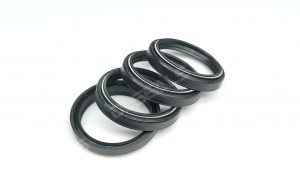 Among the many components of a motorcycle, the fork seal may seem insignificant, but it plays the role of a “guardian,” crucial to riding safety, handling performance, and the overall riding experience. It is small, yet it is the key to the proper functioning of the front forks and rear shock absorbers. If it fails, even the top-tier suspension system can be rendered useless in an instant.
Among the many components of a motorcycle, the fork seal may seem insignificant, but it plays the role of a “guardian,” crucial to riding safety, handling performance, and the overall riding experience. It is small, yet it is the key to the proper functioning of the front forks and rear shock absorbers. If it fails, even the top-tier suspension system can be rendered useless in an instant.
I. Core Function: What Exactly Is It?
The motorcycle fork seal, typically located between the inner and outer tubes (the sliders) of the suspension fork, is a multi-functional precision component. Its core mission is:
- Sealing the Hydraulic Oil:Ensuring that the hydraulic oil inside the fork does not leak. Hydraulic oil is the medium through which the shock absorber performs its damping function (absorbing and dissipating impact energy). If the oil leaks, the suspension becomes soft, ineffective, or fails completely.
- Keeping Out Contaminants:Preventing external pollutants like dust, mud, and rainwater from entering the suspension internals. These impurities can severely wear down the precision-finished inner tube surface and the seal itself, leading to oil leaks and performance degradation.
- Scraping Off Dirt:The lip of the seal is designed to act as a “wiper.” As the suspension compresses and rebounds, it continuously scrapes away dust and water adhering to the inner tube, creating a dynamic barrier.
In short, the fork seal is a “one-way valve” that guards the clean oil and precision components inside the suspension, ideally letting nothing out (oil) and nothing in (contaminants).
II. Demanding Service Conditions: Why It Must Be Tough
The working environment of a fork seal is extremely harsh, far beyond that of ordinary seals:
- High-Frequency Reciprocating Motion:It must withstand hundreds or even thousands of compression and rebound cycles per minute, a huge test for the material’s elasticity and wear resistance.
- Extreme Pressure and Friction:During hard braking or hitting bumps, the oil pressure inside the fork spikes instantly, putting tremendous stress on the seal. Simultaneously, there is constant dry or boundary friction between it and the inner tube.
- Extreme Temperature Variations:During aggressive riding or long tours, continuous compression and friction can raise fork temperatures to 80°C or higher; while riding in winter or rain, temperatures can be very low. The seal material must remain elastic across a wide temperature range.
- Exposure to Harsh Environments:It directly faces road debris, stone impacts, rainwater, as well as UV radiation and ozone aging.
- Chemical Compatibility:It must long tolerate immersion in fork oil without excessive swelling or hardening.
III. Performance Requirements and Material Evolution: From Rubber to PTFE
Based on the above conditions, an excellent fork seal must possess the following properties:
- Low Friction Coefficient:Provides smooth suspension action, reduces stiction, and improves handling sensitivity.
- High Wear Resistance:Ensures long service life under frequent reciprocating motion and contaminant attack.
- Excellent Oil and Temperature Resistance:Maintains elasticity and sealing ability in hot oil.
- Superior Conformity:Able to closely follow the inner tube surface, providing effective sealing even if the tube has minor scratches or is out-of-round.
In terms of materials, evolution has occurred in two main stages:
- Traditional Nitrile Rubber (NBR) Seals:
- Characteristics:Low cost, good oil resistance and elasticity, standard equipment on most original suspension systems.
- Disadvantages:Relatively high friction coefficient; durability and smoothness may be insufficient for high-performance or aggressive riding.
- Polytetrafluoroethylene (PTFE) Seals:
- Characteristics:The preferred choice for high-performance aftermarket upgrades and top-tier models. PTFE material has an extremely low friction coefficient(about 1/10th of rubber) and exceptional wear resistance.
- How it works:PTFE seals are often used with an O-ring. The O-ring provides constant radial pressure, while the PTFE lip achieves perfect sealing with low friction.
- Advantages:Significantly improves suspension smoothness and response, providing unparalleled road feel and feedback, while offering a very long service life. A “magic weapon” for enhancing handling experience.
IV. Importance: A Small Seal, A Big Impact
A properly functioning seal ensures:
- Stable Handling:Maintains consistent damping force, ensuring tire contact with the road.
- Riding Safety:Leak-free forks ensure sufficient support during braking, preventing excessive “dive.”
- Cost-Effectiveness:Avoids expensive overhaul or replacement of the entire suspension unit due to oil leaks.
V. Maintenance and Replacement Advice
- Regular Cleaning:After washing the bike, wipe the outer surface of the inner tubes (stanchions) clean with a soft cloth.
- Use Dust Seals/Dust Wipers:Dust seals are the first line of defense for the oil seal, effectively blocking most dirt and grime. Ensure they are properly installed.
- When to Replace:If you notice obvious oil streaks on the inner tubes, the seal is starting to fail and should be replaced promptly. It’s often recommended to inspect or replace seals when changing the fork oil.
- Professional Installation:Installing seals requires special tools and expertise. Improper installation can damage the new seal instantly; it is advisable to have it done by a professional mechanic.
Conclusion
The motorcycle fork seal, this small component hidden within the suspension, is the bridge connecting aggressive handling and safety. It silently endures the toughest conditions, and its performance directly determines the upper limit of the suspension’s capabilities. Understanding it, maintaining it, and choosing high-performance products (like PTFE seals) when needed is not only responsible bike maintenance but also the greatest guarantee for your riding safety. It truly deserves its title as a vital “guardian” in the motorcycle’s dynamic system.
Post time: Nov-14-2025
